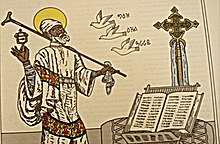Yared (musician)
Yared ( Amharic ያሬድ , * April 5, 505 in Aksum ; † May 11, 571 in the Semien Mountains ) was a semi-legendary ancient Ethiopian church musician, music theorist, priest and saint of the Ethiopian Orthodox Church from the time of the Empire of Aksum . Yared is considered to be the father of Ethiopian church music and the originator of the ancient Ethiopian notation . The feast day of Saint Yared is May 19th, according to the Ethiopian calendar the 11th Genbot.
life and work
The development of the Ethiopian musical notation
Yared came from a Christian family. Little is known about his family background. He was a disciple of the Nine Saints under whom he was ordained a priest. He has been studying since he was six. During his third phase of study, he reached an intellectual level that enabled him to develop musical notation. Yared had developed a deep passion for music and composed religious hymns and songs. He summarized his songs in the work The Book of Digua (songs of mourning and tearful songs in the language of Ge'ez). He arranged his compositions in three modes, staggered scales that were supposed to reflect the trinity of God. With these modes he mapped the ten notes Yizet, Deret, Rikrik, Difat, Cheret, Qenat, Hidet, Qurt, Dirs and Anbir. His notation consisted of lines, curves and points, each with a specific meaning. Yared developed this notation system centuries before the European seven-letter notation system.
Yared in the legend
The legend tells how Yared became the father of Ethiopian church music: Yared was reached in a precarious situation during his calling by God. He ambushed the seductress, his wife, with a bow and specific murderous intentions. God sent him three birds of paradise. One of these birds addressed Yared in a human voice. “Why do you think of murder in your heart. Isn't the priesthood itself superior to the kingdom and all things? ”Yared was then raptured into heaven, heard the seraphim and had twenty-four heavenly priests instruct him in their ways of singing. Thus, Ethiopian church music in all its dimensions - notes, singing, instrumental music, even with regard to the instruments - starts from heaven and not from earth.
According to another legend, the king put his iron staff on Yared's foot while Yared was singing. Because of the sweetness of the melody, Yared didn't notice his bleeding foot. He became a martyr for the sake of the song of God. “His blood flowed like water out of the church.” The king wanted to heal his wrongdoing and said to Yared: “Ask me what you want as the price for your blood.” After the promise was sealed, Yared replied: “Dismiss me, so that I may go away and become a monk. ”Yared left the royal court, went into the wilderness and prayed until after a few years he died in the wilderness.
meaning
Saint Yared died at the age of 66. Yared had developed all musical innovations both from formal studies and from experience in and with nature. Although Yared is hardly known outside Ethiopia, he must be counted among the most important music innovators of the Middle Ages.
swell
- Kai Merten: Ethiopian Orthodox Christianity: An attempt to understand. LIT Verlag, Münster 2012, ISBN 978-3-643-11645-1 , p. 102-103 ( google.de ).
- Charles L. Chavis (BlackPast, Global African History): Yared (Saint), 505-571 AD. April 5, 2011, accessed August 31, 2019 .
- Belai Giday: Ethiopian Civilization (WebArchive): Saint Yared. Retrieved September 1, 2019 .
- Freebase: Yared. Retrieved September 1, 2019 .
- Ethiopian Orthodox Church (translated into German by Kinfe Gebreiyesus): Ethiopian Orthodox Church Music (with a chapter on Saint Yared). Retrieved September 1, 2019 . An informative article in somewhat wheel-breaking German.
- Ethiopian Orthodox Church: A brief history of Saint Yared. Accessed August 31, 2019 .
Individual references and comments
- ↑ survival data by Charles L. Chavis in Black Past. Ethiopianorthodoxchurch.org gives completely different dates of life. According to this, Yared was only born on April 5, 525 and was only 46 years old.
- ^ Hans Hickmann: Ethiopian church music. In: Friedrich Blume (Hrsg.): The music in past and present (MGG). First edition, Volume 1 (Aachen - Blumner). Bärenreiter / Metzler, Kassel et al. 1949, DNB 550439609 , column 107 (= digital library volume 60, p. 1044). There: "St. Yared is considered the creator of [Ethiopian] church chants."
- ↑ a b c d e f g h i j k l m n o p q Kai Merten: The Ethiopian Orthodox Christianity. Yared.
- ↑ a b c d e f g h i j k l m n Charles L. Chavis: BlackPast. 2011. Yared.
- ^ Hans Hickmann: Ethiopian church music. In: Friedrich Blume (Hrsg.): The music in past and present (MGG). First edition, Volume 1 (Aachen - Blumner). Bärenreiter / Metzler, Kassel et al. 1949, DNB 550439609 , column 110 (= digital library volume 60, p. 1047). There it is said about the Ethiopian sistrum: “According to an Abyssinian legend, they received it from St. Yared, the creator of the liturgical chant, who is said to have invented it to imitate the song of birds (sic), and in its arrangement to symbolize the Holy Trinity with three cross bars and three metal rattle discs each. "
| personal data | |
|---|---|
| SURNAME | Yared |
| BRIEF DESCRIPTION | semi-legendary old Ethiopian church musician, music theorist, priest and saint |
| DATE OF BIRTH | April 5, 505 |
| PLACE OF BIRTH | Aksum |
| DATE OF DEATH | May 11, 571 |
| Place of death | Semien Mountains |
